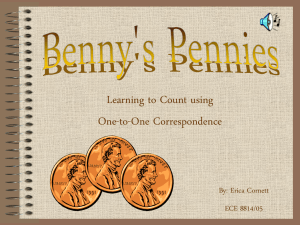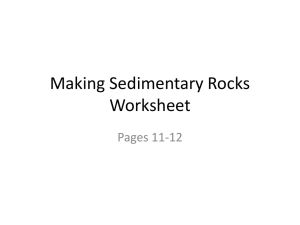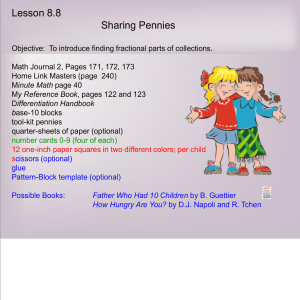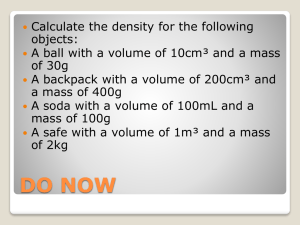Penny Lab
advertisement
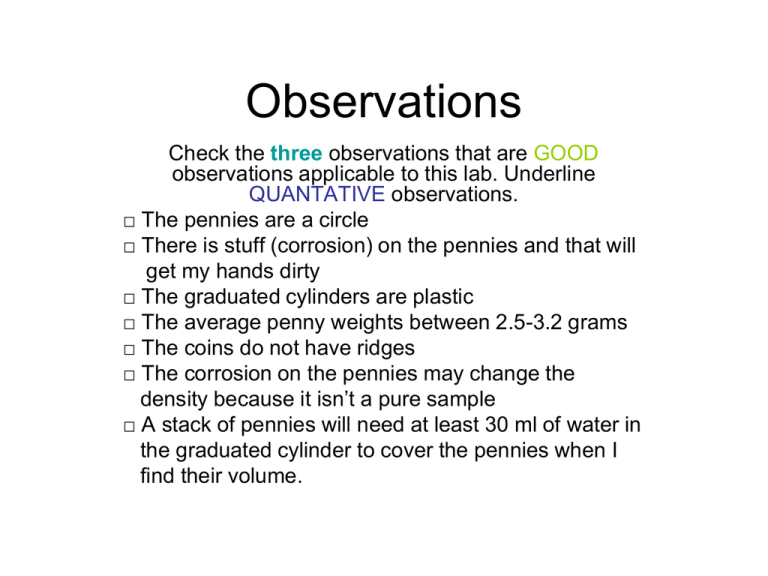
Observations Check the three observations that are GOOD observations applicable to this lab. Underline QUANTATIVE observations. □ The pennies are a circle □ There is stuff (corrosion) on the pennies and that will get my hands dirty □ The graduated cylinders are plastic □ The average penny weights between 2.5-3.2 grams □ The coins do not have ridges □ The corrosion on the pennies may change the density because it isn’t a pure sample □ A stack of pennies will need at least 30 ml of water in the graduated cylinder to cover the pennies when I find their volume. Observations Check the three observations that are GOOD observations applicable to this lab. Underline QUANTATIVE observations. □ The pennies are a circle □ There is stuff (corrosion) on the pennies and that will get my hands dirty □ The graduated cylinders are plastic ■ The average penny weights between 2.5-3.2 grams □ The coins do not have ridges ■ The corrosion on the pennies may change the density because it isn’t a pure sample ■ A stack of pennies will need at least 30 ml of water in the graduated cylinder to cover the pennies when I find their volume. Hypothesis • Put a check next to the BEST hypothesis for this Question □ If I calculate the density of the pennies, then I think the pennies will be made of copper because their color matches copper. □ If I measure the mass of the pennies without corrosion, then the density will be different then dirty ones because the dirt adds extra mass. □ If I measure the mass and the volume, then I can calculate the density because the formula is D = m/v. Hypothesis • Put a check next to the BEST hypothesis for this Question ■ If I calculate the density of the pennies, then I think the pennies will be made of copper because their color matches copper. □ If I measure the mass of the pennies without corrosion, then the density will be different then dirty ones because the dirt adds extra mass. □ If I measure the mass and the volume, then I can calculate the density because the formula is D = m/v. Experiment 1) Use the digital balance to measure the mass of the pennies. 2) Make sure the balance is measuring in grams. 3) Zero or Tare out the weighing cup (used to protect the scale). 4) Place 10, 15, & 20 pennies in the cup and record mass in the data table. 5) Put 50.0 ml of water in the graduated cylinder. 6) Be sure to get down to eye level, place it on a flat surface and read the bottom of the meniscus when pouring our water. 7) Hold the tube at an angle and slide the pennies (10, 15 and then 20) into the graduated cylinder to make sure it doesn’t splash. 8) Again, using the technique in step 6 read the final volume of the cylinder. 9) Subtract the final volume from the initial (starting) volume and record in the data table in ml. 10) Repeat 3 times for each set of pennies and find the averages by adding the numbers and dividing by the total trials for both mass and volume 11) To calculate density, divide average mass by the average difference in volume. 12) Record the Density in g/ml in the data table. 13) Compare the density you find with the reference table to determine the kind of metal and record it in the data table. Experiment 1) Use the digital balance to measure the mass of the pennies. 2) Make sure the balance is measuring in grams. 3) Zero or Tare out the weighing cup (used to protect the scale). 4) Place 10, 15, & 20 pennies in the cup and record mass in the data table. 5) Put 50.0 ml of water in the graduated cylinder. 6) Be sure to get down to eye level, place it on a flat surface and read the bottom of the meniscus when pouring our water. 7) Hold the tube at an angle and slide the pennies (10, 15 and then 20) into the graduated cylinder to make sure it doesn’t splash. 8) Again, using the technique in step 6 read the final volume of the cylinder. 9) Subtract the final volume from the initial (starting) volume and record in the data table in ml. 10) Repeat 3 times for each set of pennies and find the averages by adding the numbers and dividing by the total trials for both mass and volume 11) To calculate density, divide average mass by the average difference in volume. 12) Record the Density in g/ml in the data table. 13) Compare the density you find with the reference table to determine the kind of metal and record it in the data table. Experiment 1) Use the digital balance to measure the mass of the pennies. 2) Make sure the balance is measuring in grams. 3) Zero or Tare out the weighing cup (used to protect the scale). 4) Place 10, 15, & 20 pennies in the cup and record mass in the data table. 5) Put 50.0 ml of water in the graduated cylinder. 6) Be sure to get down to eye level, place it on a flat surface and read the bottom of the meniscus when pouring our water. 7) Hold the tube at an angle and slide the pennies (10, 15 and then 20) into the graduated cylinder to make sure it doesn’t splash. 8) Again, using the technique in step 6 read the final volume of the cylinder. 9) Subtract the final volume from the initial (starting) volume and record in the data table in ml. 10) Repeat 3 times for each set of pennies and find the averages by adding the numbers and dividing by the total trials for both mass and volume 11) To calculate density, divide average mass by the average difference in volume. 12) Record the Density in g/ml in the data table. 13) Compare the density you find with the reference table to determine the kind of metal and record it in the data table. Experiment 1) Use the digital balance to measure the mass of the pennies. 2) Make sure the balance is measuring in grams. 3) Zero or Tare out the weighing cup (used to protect the scale). 4) Place 10, 15, & 20 pennies in the cup and record mass in the data table. 5) Put 50.0 ml of water in the graduated cylinder. 6) Be sure to get down to eye level, place it on a flat surface and read the bottom of the meniscus when pouring our water. 7) Hold the tube at an angle and slide the pennies (10, 15 and then 20) into the graduated cylinder to make sure it doesn’t splash. 8) Again, using the technique in step 6 read the final volume of the cylinder. 9) Subtract the final volume from the initial (starting) volume and record in the data table in ml. 10) Repeat 3 times for each set of pennies and find the averages by adding the numbers and dividing by the total trials for both mass and volume 11) To calculate density, divide average mass by the average difference in volume. 12) Record the Density in g/ml in the data table. 13) Compare the density you find with the reference table to determine the kind of metal and record it in the data table. Conclusion I reject my hypothesis. My data did not support that pennies were made of copper. My density was between 7.1 & 7.2 which matched Zinc the closest. The pattern that I noticed is that it didn’t matter how many pennies I used, I still got the same answer. In conclusion, pennies from 1993-94 are made of zinc. Conclusion I reject my hypothesis. My data did not support that pennies were made of copper. My density was between 7.1 & 7.2 which matched Zinc the closest. The pattern that I noticed is that it didn’t matter how many pennies I used, I still got the same answer. In conclusion, pennies from 1993-94 are made of zinc. Errors An error that I made in my measurement is that I didn’t weigh my pennies when they were dry and that extra mass could have messed up my density. Another error could have been that there were water droplets on the side of the tube and when I slide the pennies in, it pushed extra water into the volume. Last, I didn’t always remember to get down to eye level and look at the meniscus. This would have explained why my volume wasn’t consistent. A suggestion for next time is it to test pennies that are older to see they are also made of zinc. Errors An error that I made in my measurement is that I didn’t weigh my pennies when they were dry and that extra mass could have messed up my density. Another error could have been that there were water droplets on the side of the tube and when I slide the pennies in, it pushed extra water into the volume. Last, I didn’t always remember to get down to eye level and look at the meniscus. This would have explained why my volume wasn’t consistent. A suggestion for next time is it to test pennies that are older to see they are also made of zinc. For Further Investigation • If you are denser than the liquid you will sink. The only 2 that are more dense are gold and platinum. • OR!!! If there is no for further investigations question by the teacher, tell where you would see it in real life

